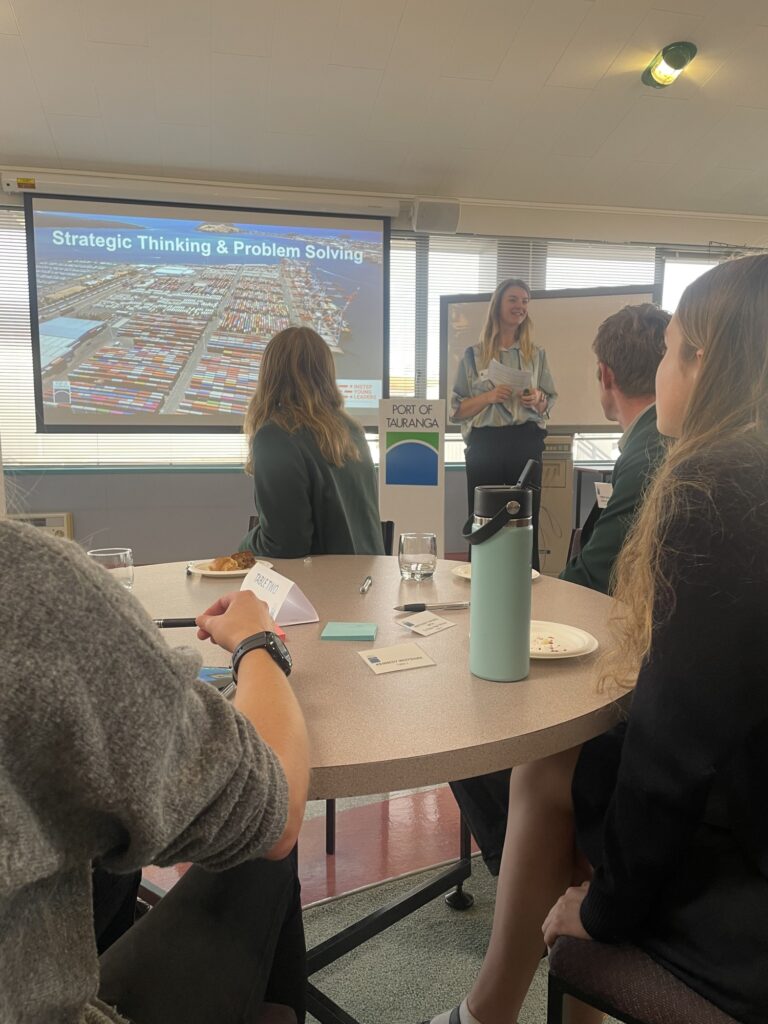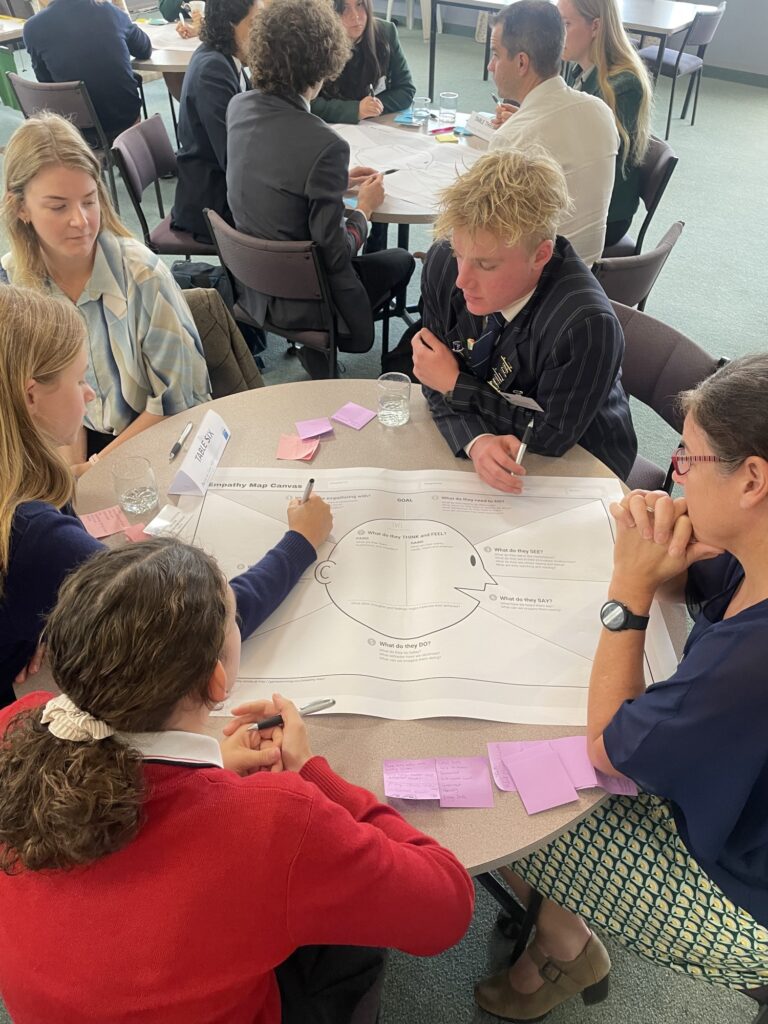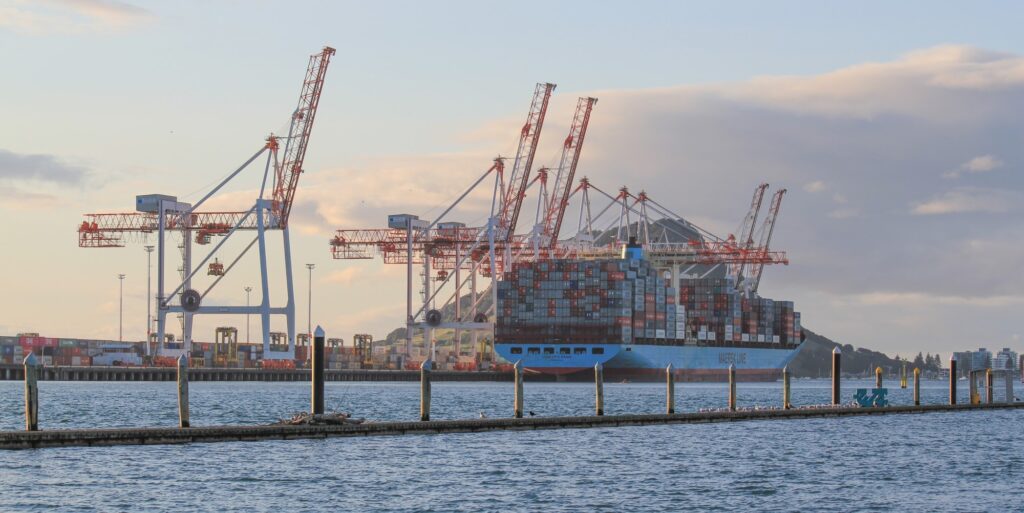Latest News
The Instep Young Leaders recently attended their second business breakfast, hosted by the Port of Tauranga. The success of the Young Leaders’ Forum business breakfast highlights the crucial role our business community play in exposing students to what is available in the community and by providing learning and networking opportunities for those interested in pursuing these pathways to careers in related fields.
During the breakfast event, Port staff, Dave Bishop (Marine Operations Manager), Dan Ah Sam (Terminal Planning Supervisor), Fenna Beets (Environmental Advisor) and Gavin Collinson (Straddle & Yard Operations Supervisor) joined the Young Leaders to participate in the activities that began with Rochelle Lockley, GM of Communications giving an in-depth history of the Port and its operations. From there the groups collaborated in workshop activities designed around ‘Strategic Thinking and Problem Solving’ facilitated by Rachael Nunn, Group Human Resources Advisor. Leaders were asked to warm up and get their creative juices flowing by coming up with six-word stories. They were then posed with a question. For the Port to grow and handle the demand, a new system that maximises the current footprint and creates efficiency needs to be designed.


After a robust discussion and a sharing of ideas the group watched a short, animated video presenting how the Port will handle the automation and expansion plans. This segued into an exercise called, Empathy Map-designed to understand the perspectives of Port stakeholders and what impact the needs of stakeholders will have on the strategic decision making for the Port. Students were asked to create an extensive list of stakeholders, which included, the natural environment, Iwi, Mount residents, employees, government, customers, and recreational users. The Leaders were then divided into groups to focus on one type of stakeholder and to identify the ways they may be impacted both negatively and positively.
The Instep Young Leaders gained valuable insights into the operations of the Port of Tauranga. They learned about the Port’s commitment to maintaining air and water quality and its plans to expand and automate operations while staying responsive to the sustainability of the region by reducing carbon emissions. The collaborative workshop activities on strategic thinking and problem-solving provided an excellent opportunity for the students to learn about the impact the Port has on Tauranga Moana and the importance of supply chains and logistics services and how they contribute to job creation and wealth generation in our region. Rachael discussed the growth of the Port and the many new roles and employment pathways that will be available. The group left having a greater appreciation for the value the Port offers. Thank you to all the team at the Port of Tauranga for making this event remarkable.
About the Port of Tauranga

This Port is the only one in the country that can accommodate the largest container vessels and handles a third of all cargo in New Zealand. Additionally, it is responsible for nearly 40% of New Zealand’s exports and almost half of all shipping containers. The Port of Tauranga offers highly effective supply chains, inland freight hubs, cargo handling expertise, and logistics services. The facilities in Tauranga include the country’s largest and fastest-growing container terminal, extensive bulk cargo wharves and storage facilities, and bunker berths. The company’s presence in the Bay of Plenty has created jobs and wealth for the Tauranga community, the broader region, and beyond.
The Port of Tauranga is well-connected to state highways and has rail connections to Hamilton, Auckland, and the central North Island. The Port spans 190 hectares on both sides of the harbour, with inland ports in Auckland and Hamilton. In addition to being a gateway for freight, the Port of Tauranga is also a cruise terminal. Last summer, the city saw 90 ships docking, with the largest carrying approximately 4,000 passengers plus crew. When not being used for cruise ships, the number one berth is used by kiwi fruit-chartered vessels using refrigerated containers. On the mount side are bulk hauls storing all bulk cargo, such as fertiliser, coal, salt, wheat, and barley that come in on ships.
The Port of Tauranga is committed to maintaining air and water quality around its facilities. Sweeper trucks operate 24/7 and wind fences were installed to slow down the wind, allowing dust and debris from the logs to settle and be swept up. A dedicated team tests the water and continuously collects and tests stormwater. The sand from dredging is recycled back onto local beaches and used for roading projects. However, they stop using the sand during certain times of the year as it has become a popular nesting place for birds, including a few endangered species that fly here all the way from Alaska.
The Port of Tauranga uses refrigerated, temperature-controlled white containers to transport ice cream, meat, and dairy products. They have nine container cranes and fifty-three straddle carriers to move the containers. There is a ten-lane truck exchange and a vehicle booking system that encourages vehicles to come at off-peak hours to reduce congestion on Tauranga roads.
The Port is transitioning the straddle fleet to hybrids, which will improve performance. They are also adding new cranes and equipment to reduce their carbon emissions. The Port of Tauranga is the only port in New Zealand that can handle larger container vessels of up to 11,000 TEUs (Twenty equivalent units) and handles over 1.2 million TEUs every year. They are focused on extending the container berth to have more capacity to take larger ships and want to automate part of the terminal to intensify the number of containers they can have within their existing footprint.
